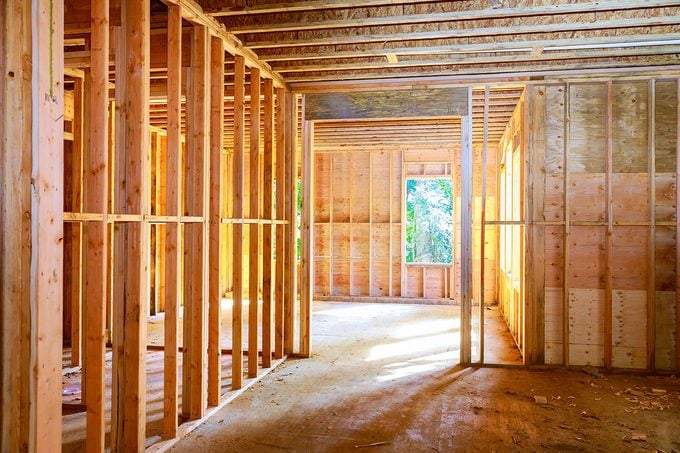How To Repair Load Bearing Beams
Non all walls are created equal. Larn about the importance of load-begetting walls and how to identify them in your home.
The walls of your home do more than only carve up rooms or keep the elements and intruders at bay. Certain walls also serve the essential function of keeping your dwelling house standing. These all-important walls are known as load-bearing walls.
Removing a wall tin can be a tempting DIY project, but mistakenly removing a load-bearing wall tin can crusade significant structural harm to your dwelling house and render it unsafe. Earlier removing any wall, determine if it is load-begetting, and if so, leave it lone. Here'south what yous demand to know.
What Is a Load-Bearing Wall?
A load-begetting wall (AKA structural wall) supports the weight of the structures to a higher place it, such every bit the roof and the upper floors of multi-story homes. The weight of the structures they support is often referred to as the "load," and load-bearing walls are designed to transfer the force of the load down into the abode's foundation.
Not load-bearing walls (AKA partitioning or curtain walls) don't serve any structural purpose and are primarily used every bit room dividers.
Why Are Load-Bearing Walls Necessary?
Essentially, load-begetting walls keep your home from caving in on itself. Removing one of these walls without the necessary precautions volition substantially compromise the structural integrity and safety of your domicile.
Before a load-bearing wall tin be removed, temporary walls need to be installed on either side of it to support the load it's begetting. A structural beam then needs to be installed underneath or in-betwixt the ceiling joists where the load-bearing wall was located. This beam needs to possess the aforementioned load-bearing capacity as the wall it's replacing, and should ideally be selected by an engineer.

How Can You Tell If a Wall Is Load Begetting?
You should always consult with a full general contractor, architect or structural engineer to determine if a wall is load-bearing before you remove it. Nevertheless, there are a few tell-tale signs that a wall might be load-bearing. You lot can discover these by inspecting the wall'due south framing from your attic, basement or the habitation's blueprints.
-
Outside walls. Exterior walls effectually the outside perimeter of your home are typically load-begetting.
-
Stacked walls in a multi-story home. Interior walls that are located directly on elevation of 1 another are usually load-bearing. You tin either view your home'southward blueprints to see which walls are direct on top of each other, or measure the distance betwixt the exterior and interior walls on each floor. If each interior wall is the same distance away from the exterior wall, they are probably load-begetting.
-
Walls that run perpendicular to the ceiling joists. Walls that run perpendicular (at a 90 degree bending) to the ceiling joists are load-bearing. Walls that run parallel (in the same management) as the ceiling joints are non load-bearing.
-
Ceiling joists are spliced over the wall. Interior load-bearing walls will often have the ends of ceiling joists meet and overlap (AKA splice) over the wall.
-
Support structures under the wall. Walls with a axle, column or jack posts directly underneath them are likely load-bearing.
-
The wall is marked with an "S" on the blueprints. Load-bearing walls will oft be marked with an "S" (for structural).
Source: https://www.familyhandyman.com/article/load-bearing-walls/
Posted by: washingtonnoremorkes.blogspot.com


0 Response to "How To Repair Load Bearing Beams"
Post a Comment